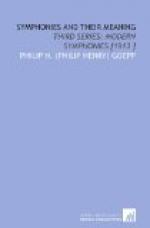[Music: Allegro animato (Violins) Marcato (Trumpets and trombones)]
regnant air in the brass. A (canon) chase of echoing voices merely adds an entrancing bewilderment, then yields to other symbols and visions.
Still rises the thread of pulsing strings to higher empyraean and then floats forth in golden horns, as we hang in the heavens, a melody tenderly solemn, as of pent delight, or perhaps of a more fatal hue, with the solar orb encircled by his satellites.
Still on to a higher pole spins the dizzy path; then at the top of the song, it turns in slow descending curve. Almost to Avernus seems the gliding fall when the first melody rings anew. But there is now an anxious sense that dims the joy of motion and in the
[Music: (With trembling of violins in high B flat) (Horns)]
returning first motive jars the buoyant spring. Through the maze of fugue with tinge of terror presses the fatuous chase, when—crash comes the shock of higher power. There is a pause of motion in the din and a downward flight as of lifeless figure.
Now seems the soul of the sweet melody to sing, in purest dirge, without the shimmer of attendant motion save a ghostly shadow of the joyous symbol.
THE YOUTH OF HERCULES
The “Legend” is printed in the score as follows:
“Fable tells us that upon entering into life Hercules saw the two paths open before him: of pleasure and of virtue.
“Insensible to the seductions of Nymphs and Bacchantes, the hero devotes himself to the career of struggle and combat, at the end of which he glimpses across the flames of the funeral pyre the reward of immortality.”
We can let our fancy play about the score and wonderfully hit an intention of the poet. Yet that is often rather a self-flattery than a real perception. In the small touches we may lose the greater beauty. Here, after all, is the justification of the music. If the graphic picture is added, a little, only, is gained. The main virtue of it lies in our better grasp of the musical design.
In the muted strings, straying dreamily in pairs, is a vague line of the motto,—a foreshadowing of the heroic idea, as are the soft calls of the wind with wooing harp a first vision of delight.
[Music: Allegro moderato (Strings)]
Now begins the main song in sturdy course of unmuted strings. The wood soon join in the rehearsing. But it is not all easy deciphering. The song wanders in gently agitated strings while the horns hold a solemn phrase that but faintly resembles the motto.[A] Lesser phrases play about the bigger in rising flight of aspiration, crowned at the height with a ray of glad light.
[Footnote A: It is well to resist the vain search for a transnotation of the story. And here we see a virtue of Saint-Saens himself, a national trait of poise that saved him from losing the music in the picture. His symphonic poems must be enjoyed in a kind of musical revery upon the poetic subject. He disdained the rude graphic stroke, and used dramatic means only where a musical charm was commingled.]




